I quite agree.....
But I think I can answer your question about why.
Meyer and Moran weren't really trying to "perform science" or "add to basic knowledge" in the general sense.
They quite specifically set out to determine if most people would find the entire CD reproduction chain to be "audibly transparent" or not.
They were looking for the answer to a particular question - but the question itself was somewhat broad.
They were basically testing the assertion that "most people won't hear the difference" as a "yes or no proposition".
They were hoping to cover a variety of different variables "in one go" and be able to deliver a general conclusion that "none of the variables made any difference".
(The alternative result would have simply been: "some of the variables apparently made a difference after all".)
I've had similar experiences to yours with converters.
One time I downloaded two files, both converted from the same DSD x 2 original to 24/96k PCM, but using two different top rated converter programs (both at their default settings).
The author posted them to ask opinions about which one was preferred (the test was blind in that we weren't told which file had been made using which converter).
I would not say that one file sounded better than the other - and I would have been perfectly satisfied with either one - but there were tiny differences.
And, once discussion started, it was plain that most listeners noticed similar differences.
And, yes, these were differences in the audible frequency range, that could be seen on an editor..... but they were tiny.
For example, at one point in the recording, a small bell was struck several times.....
- in one copy the first strike seemed to be louder than the subsequent strikes
- but, in the other copy, the second strike seemed to be slightly louder than the first (or the first strike was slightly subdued)
(and, yes, when you looked at both in an editor, the waveforms looked a little different)
Were they important or significant differences?
No.
Could I have identified, in a test using other files, which converter was used?
I very much doubt it.
But, were the files "audibly identical"?
No.
The problem with the Meyer and Moran study is that is testing too many variables at once so it more surprising how many participants ending in the random chance range. They are reducing bandwidth, reducing resolution and then just for fun they are add a second piece of equipment in one of the playback chains introducing countless variables. Only three people or three trials (I can't tell from the paper) could tell something better than random chance.
This was done years after Bob Katz and JJ did the 44k vs 96k tests which JJ right insisted they be a single variable test, why is Meyer and Moran not a single variable test? Bob was very excited about 96k when it came out, JJ told him it made no deference, unlike here they spend many month hashing out the test protocol, Bob creating the test recordings , JJ writing the 96k and 44k filters. While Bob was preping the recordings he admitted he could not tell the difference between the original , the 96k filtered and 44k filtered. All in one of the top master studios in the world with the best equipment you can find.
Pat Brown runs Syn-Aud-Con and teaches audio professionals around the world. When the Pono was released there was much discussion about wider bandwidth among the members. Pretty much the same we have here, once again Pat and others came up with a test, assembled the equipment and the recordings, filtered to 96k filtered to 44k and added one that only had 20k and up. Pat has let hundreds of people who make their living in audio run those tests no missing links so far.
I did not want to admit this in this never ending circular discussion, I do have convertors that I can hear the difference between, and before all the audiophiles scream see!!!. It is not night and day, in fact it takes a low noise room an extreme amount of focus and the right point in a certain track. I discovered it while testing something else, (like data compression artifacts) I was testing at work it was something barely audible like a soft brush note in fairly busy part of the song but I could catch it most times. It was getting late, I decided to finish testing later at home. I forgot to pack the convertor. No big deal I have others, well on the other one I could not hear it. So was the first one broken, or is reveling some the second one couldn't?






















